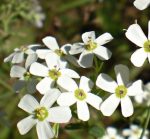 Also called prairie baby’s breath, flowering spurge is a herbaceous perennial and member of the euphorbia family, Euphorbiaceae, that also includes poinsettia, caster oil plant, and cassava. It is native to North America from Texas north to South Dakota and east to the Atlantic coast. Plants prefer full sun and mesic to dry, well-drained soil and are found in open woodlands, prairies, pastures, glades, abandon fields, mined lands, and in waste areas as well as along roadsides and railroad train tracks.
Also called prairie baby’s breath, flowering spurge is a herbaceous perennial and member of the euphorbia family, Euphorbiaceae, that also includes poinsettia, caster oil plant, and cassava. It is native to North America from Texas north to South Dakota and east to the Atlantic coast. Plants prefer full sun and mesic to dry, well-drained soil and are found in open woodlands, prairies, pastures, glades, abandon fields, mined lands, and in waste areas as well as along roadsides and railroad train tracks.
Description: Growing from a deep tap root, flowering spurge is one to three feet tall and has smooth light green stems that are branched at the top. The oblong leaves are gray-green to green, , up to 2 1/2 inches long, and alternate to the top where they form a whorl of three or more around the inflorescence. Both leaves and stem contain a white latex that may cause skin and eye irritation. The male and female flowers are 1/4″ across and lack petals but have white petaloid bracts, and are carried on the same plant in loose terminal panicles up to 1″ across. They bloom throughout the summer and the female flowers give way to three sided capsules. Plants spread by seed and short rhizomes.
Control: Pull, plow, mow, or cut seedlings as they appear. Dig out older plants being careful to get as much as the deep taproot as possible as it can resprout if small pieces are left in the soil. Make sure that flowers are removed before seed set. A dense mulch such as newspaper or cardboard can be put over the whole area for one growing season.